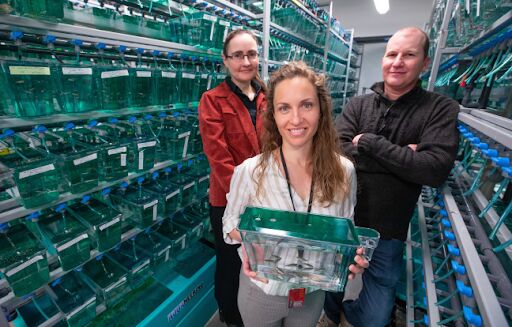Iowa State blood stem cell research may help treat leukemia

Image Courtesy of Christopher Gannon
Raquel Espin Palazon (center) and two researcher team members in the zebrafish room located in the basement of the Advanced Teaching and Research Building.
April 18, 2022
Iowa State researchers seeking to understand how blood stem cells are formed hope their research will help treat blood diseases such as leukemia and anemia.
Raquel Espin Palazon, an assistant professor of genetics, development and cell biology, is the principal investigator for the research team comprised of four other Iowa State personnel and one researcher from the Children’s Hospital of Philadelphia.
The research team is currently examining a genetic pathway that is triggered when cells undergo inflammation caused by injury or infection. This pathway has an important part in the development of blood stem cells, undifferentiated cells which do not have specialized structures or functions, according to the National Cancer Institute.
“We are very interested in understanding how blood stem cells form,” Espin Palazon said. “We have a few [blood stem cells] in our bone marrows that are giving rise to all our blood cells that we have.”
Espin Palazon’s team studies zebrafish to see how blood is created during embryo development in vivo. In vivo is Latin for “within the living,” which means tests, experiments and procedures are performed in or on a whole living organism. Zebrafish are used because not only do they share more than 70 percent of their genes with humans, but zebrafish embryos develop externally, not in the uterus, and are transparent.
“You can watch everything,” Palazon said. “You watch how blood stem cells are forming in real-time.”
The team also uses in vitro experiments on human cells in order to apply their findings to human health. In vitro is Latin for “in glass,” meaning procedures, tests and experiments are performed outside of a living organism like in a petri dish.
The research done by Palazon’s team has the potential to help treat blood diseases like leukemia and anemia. One current treatment for blood diseases is blood stem cell transplantations, but problems can arise with finding a donor and successfully transplanting the cells.
Palazon’s team’s research could allow a patient’s own cells to be used instead, eliminating some of the issues.
“We can potentially in the future use them for transplantation from the specific patient,” Palazon said. “[From] the patient we can take the cells, generate [their] own blood stem cells, then put them back and cure blood diseases.”
Palazon and her research team have recently received a federal grant from the National Institute of Health to help fund their research. The grant is for five years and is worth approximately $2 million to help build on their work studying the genetic pathway.
















